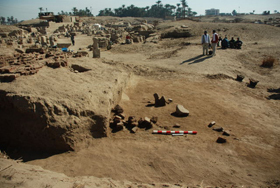Our First Week

At the end of last season we covered the baked brick building north of the Sacred Lake with plastic and sand to protect it and its plastered surfaces while we were gone. Our first job on January 17, our first day of work, was to uncover the building again.


The structure was built atop a mud brick mass that slopes away to the south toward the lake. We believe this mud brick to be the remains of the 18th Dynasty enclosure wall, much worn by time and the frequent flooding of the sacred lake. By mid-week the line where mud brick and wind- and water-borne soil meet was clear (left). By week’s end we had uncovered the south face of the mud brick all the way across the area. In the foreground of the picture on the right are baked bricks from the building above that tumbled down the slope as mud brick supporting them eroded.

Now we need to figure out how the baked brick building relates to its surroundings. To do this we opened a square just to the north on Tuesday. At the west side of the square, below a fairly thick layer of ash that covered the whole area a north-south mud brick wall is beginning to emerge. This photo, taken late in the day on Thursday, looks south across the square to the drained lake. The mud brick wall is to the right of the meter stick.


We are fortunate to have two very talented Qufti (technicians from the village of Quft) working in this area: Mahmoud Abbadi (left) and Mamdouh Kamil. Both have worked with us for many seasons.


Our third Qufti is Abdel Aziz Farouk Sharid, who is working on the mud brick structures north of the Mut Temple’s 1st pylon. Most of the work here will be painstaking scraping and brushing of surfaces so we can finally figure out the sequence of the earliest phases of the buildings. The photo on the right, looking west across the largest room, shows one result of the work this week: the potsherds in the foreground are lying on the surface on which the foundations of the room’s east wall were laid. The row of shallow depressions behind the meter stick are the holes in which the stone facing of the inner side of this room were set. This is the sort of information that is important to archaeological work but not very photogenic.

On Saturday, the first day of work, Jaap van Dijk, our inspector Osama and I got together in Chapel D to talk about further restoration work to be done here this year.


Before we can put new paving into Chapel D we need to restore the east wall of the middle room; the west wall was one of last year’s projects. For the first few days, Khaled and his team cleaned and numbered the blocks so they could be reassembled. On Tuesday, January 20 we brought in the siba (tripod and winch) and began to take the wall apart (left). By the end of Thursday, the new lower course was finished and stone masons Mohammed Gharib (left, with level) and Sayed Ahmed (in green) had the first of the large blocks back in place. Mohammed is checking to make sure it is level and lines up properly with the blocks below.

Our biggest restoration project this year is rebuilding the north wing of the Taharqa Gate, seen from the southeast in this photograph. First we removed the most badly decayed blocks of the south face of the gate and cleaned the joins between the remaining blocks, which are fairly stable. Some of the blocks of the core of the gate are visible on the right.


On the left is the core of the gate at the end of the week; it is mostly dismantled. As with Chapel D, the blocks that were removed were first numbered so that they can be put back in place later. The construction is rather shoddy, the large blocks stacked fairly loosely and spaces between them sometimes filled by thick layers of mortar, as in the top left of this photo. There were a few pieces of limestone in the core as well, only one of which was inscribed (right). Like most of the limestone we find at Mut, it has decayed badly, and getting it out more-or-less intact was a challenge. In the inscription, which is most likely New Kingdom, an unidentified god says “I give you heb-sed festivals like Re”. Heb-seds were festivals of the renewal of royal power celebrated (in theory) every 30 years.
Once work on Chapel D is finished, the conservation and restoration of this gate will begin in earnest.

Even though the lake is mostly empty, we still have some birds. Jaap van Dijk took this charming photograph of a pair of swallows collecting nesting material in the lake bed.

Richard Fazzini joined the museum as Assistant Curator of Egyptian Art in 1969 and served as the Chairman of Egyptian, Classical and Ancient Middle Eastern Art from 1983 until his retirement in June 2006. He is now Curator Emeritus of Egyptian Art, but continues to direct the Brooklyn Museum’s archaeological expedition to the Precinct of the Goddess Mut at South Karnak, a project he initiated in 1976. Richard was responsible for numerous gallery installations and special exhibitions during his 37 years at the museum. An Egyptologist specialized in art history and religious iconography, he has also developed an abiding interest in the West’s ongoing fascination with ancient Egypt, called Egyptomania. Well-published, he has lectured widely in the U.S. and abroad, and served as President of the American Research Center in Egypt, America’s foremost professional organization for Egyptologists.
